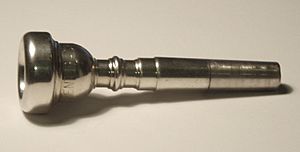Mouthpiece (brass) facts for kids
A brass mouthpiece is a special part of a brass instrument. It's where a musician blows to make a sound. The mouthpiece helps send tiny shakes, called vibrations, into the instrument. These vibrations then create a musical note.
Bigger instruments, like a tuba, use larger mouthpieces. Smaller instruments, like a trumpet, use smaller ones. This is because larger mouthpieces help make lower sounds, and smaller ones help make higher sounds.
Contents
Parts of a Brass Mouthpiece
A mouthpiece has many different parts, each with its own name and job.
- Rim - This is the circle at the top of the mouthpiece. It's the part that touches your lips when you play.
- Cup - The cup is the hollow part between the rim and the backbore. Air from your mouth enters here. Its curved shape helps push the air into the next section.
- Throat, Backbore, and Shank - The throat is a small opening where air goes from the cup. The backbore is the part after the throat. The shank is the long, hollow metal piece that connects the mouthpiece to the instrument. It's the only part of the mouthpiece that should go into the instrument.
How Mouthpiece Design Changes Sound
Even small changes in how a mouthpiece is made can greatly change an instrument's sound.
| Part of Mouthpiece | How it Changes the Sound |
|---|---|
| Inner rim diameter | A wider inner rim helps play low notes and makes the sound richer. A narrower inner rim helps play high notes, but might make low notes harder. |
| Rim width | A wider rim can make it easier to play for a long time. However, it might limit how many different notes you can play. |
| Rim contour | This is the shape of the top of the rim. Flatter rims often go with sharper rim edges. |
| Rim edge (also called bite) | A sharper rim edge can make a clearer sound. But it might also make it harder to play for a long time. |
| Cup depth | A shallow cup (not very deep) helps play very high notes. But the sound might not be as full. A deep cup makes a rich, full sound, but high notes can be harder to reach. |
| Cup shape | Cups shaped like a half-circle make notes that are easy to hear clearly. Cups shaped like cones make notes that blend together more. |
| Throat diameter | A wider throat helps you play louder. But the sound might not be as good. A narrower throat makes a very good sound, but you might not be able to play as loud. |
| Backbore | Backbores shaped like cones make a "fuller" sound. Backbores shaped like cylinders give a clear and "choppy" sound. |
Materials for Brass Mouthpieces
Mouthpieces can be made from different materials. Each material affects the sound and how the mouthpiece feels.
Gold Plating
Some players choose to gold plate their mouthpieces. This means covering them with a thin layer of gold. Gold-plated mouthpieces can make the instrument sound even better. For people who are allergic to silver, gold plating is a good way to play without getting sick. Gold doesn't smudge much, so it only needs simple cleaning with soap and water sometimes.
Silver Plating

Silver plating is very common for brass mouthpieces. It's not too expensive and helps make a good sound. Silver plating can give a clearer sound than gold. It's often chosen for playing styles that need a lot of volume. Silver does smudge easily, so it needs to be cleaned more often.
Plastic
Another type of mouthpiece is made from plastic. These mouthpieces are great because they don't break or dent easily. They also cost less than silver or gold mouthpieces. Plastic mouthpieces are often used in marching bands, especially when playing outdoors. However, they usually don't make as good a sound as metal mouthpieces.
Steel and Titanium
Some newer mouthpieces are made from stainless steel or titanium. These are quite rare, as only a few companies make them. Steel and titanium mouthpieces don't vibrate as much, which creates a very clear sound. They also need much less cleaning and don't need silver plating. But, they are usually much more expensive than silver or gold-plated mouthpieces.
Other pages
Images for kids
See also
 In Spanish: Boquilla (viento-metal) para niños
In Spanish: Boquilla (viento-metal) para niños




